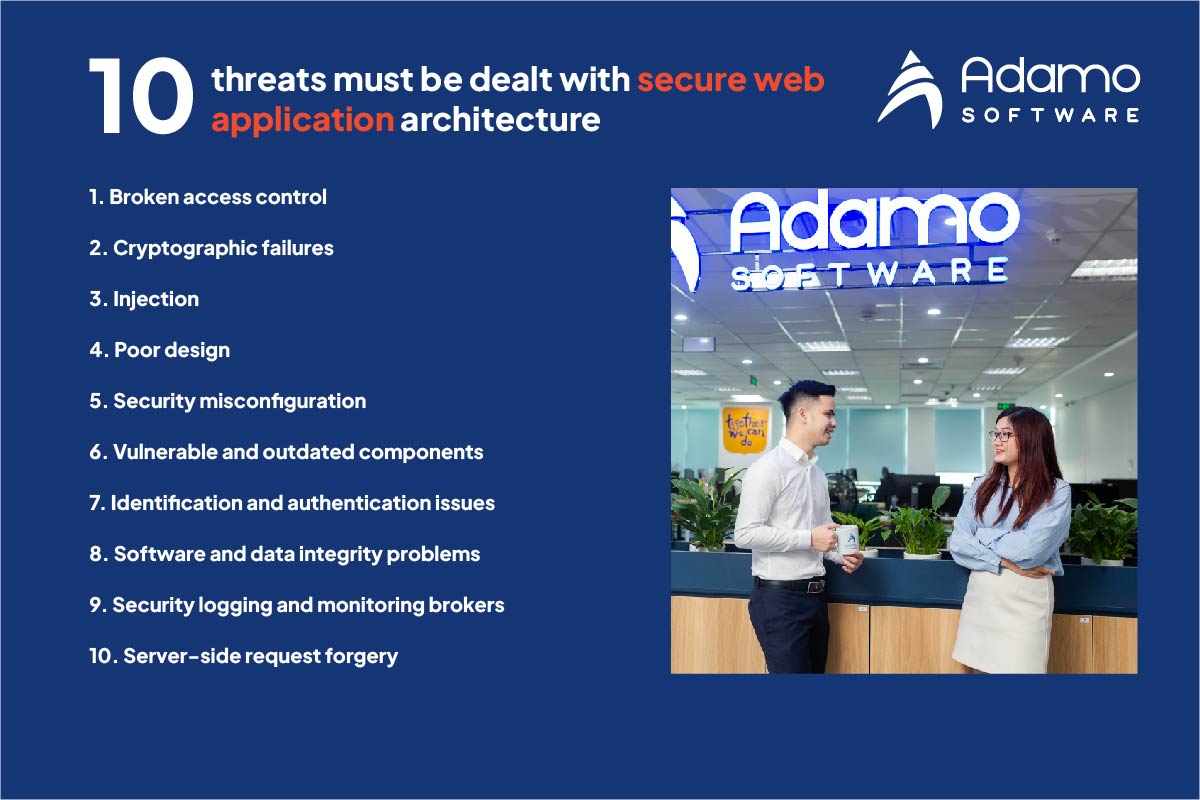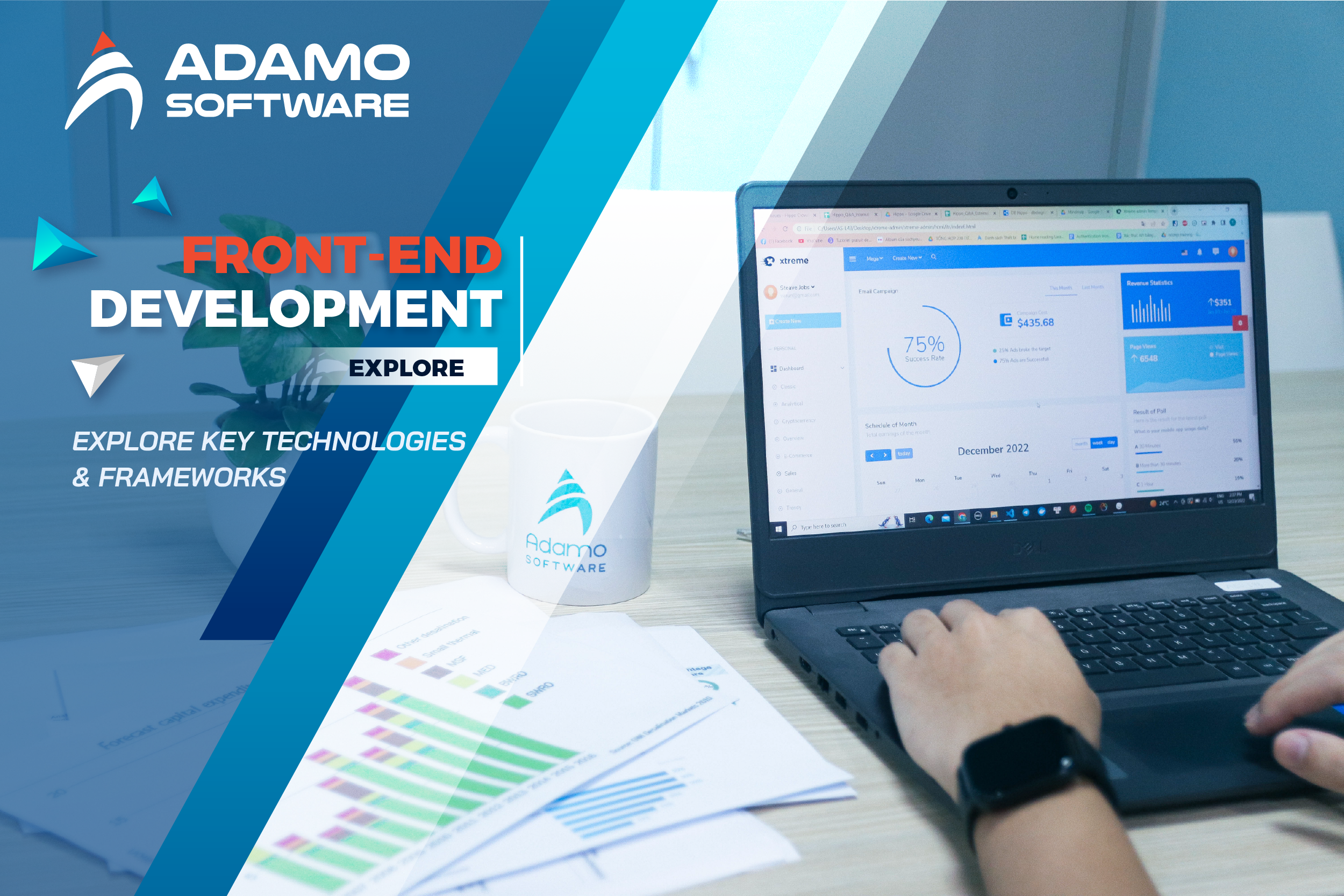Secure web application architecture: tips to prevent threats

Every day, new threats emerge that necessitate at least one modification or enhancement to the secure web application architecture.
Web apps can assist in targeting a growing number of clients and consumers in ways that were previously unavailable. Web apps can communicate with customers, provide product support, and retain their business.
We use web apps for so many purposes and transmit so much sensitive information via so many different types of online channels. Consequently, we should be required to take a firm position on secure web application architecture.
I. What is a secure web application architecture?
The advent of dynamic websites has increased the frequency with which visitors interact with websites. In contrast to their static counterparts, they enable visitors to provide personal information for activities such as sign-up and payment. However, this also presents a recurrent issue known as Security.
As cloud computing evolves, the complexity of websites and web apps continues to increase. Companies typically store even sensitive data in the cloud due to its low cost and convenience. Therefore, secure web application architecture is no longer a luxury but an absolute necessity.
So, what exactly is secure web application architecture? As a subset of information security, it encompasses everything necessary to safeguard web apps against malicious code and other cyberattacks. Specifically, businesses implement all applicable practices, policies, procedures, and technologies to protect confidential data from hackers in Internet and web app systems.
Companies develop and implement security methods for reasons beyond protecting user data. A good secure web application architecture can provide the following tangible benefits:
_ Avoid revenue loss caused by service downtime, outages, and repair and maintenance costs.
_ Boost a company’s online reputation and customer trust.
_ Ensure web apps comply with security standards (such as ISO/IEC 27001 or HIPPA) governed by local governments or international entities.
II. Why should we use secure web application architecture?
A secure web application architecture is the foundation of an organization’s defense against cyber threats and ensures that all components of its IT infrastructure are secure. A secure web application architecture protects the following environments:
_ Cloud
_ Networks
_ IoT
_ Endpoints
_ Mobile
When a secure web application architecture adheres to all seven Zero Trust security model principles (devices, people, data, networks, workload, automation & orchestration, visibility & analytics), an organization can secure data and IT resources regardless of their location.
III. Attribute of secure web application architecture
There are some attributes that a secure web application architecture should have. The article here analyzes inter-tier authentication, server-side validation, secure communication, data at rest, and logging.
1. Inter-tier authentication
Multi-tier architecture leads to different components of an app connecting with each other to obtain seamless functionality. Before transferring data with other tiers, app tiers can authenticate with each other. This makes sure that attracker can not easily impersonate components’ identity. Kerberos, mutual SSL, and IP validation are mechanisms to obtain secure web application architecture.
2. Server-side validation
Data validation can happen on the web browser or client-side, along with the web server. The web browser validation offers a seamless experience to the end-user since user-offered input data is validated faster. Besides, the client-side validation does not need a data round trip linkedin to the server, reducing server load and improving its performance.
However, execution of client-side validation is not enough to prevent malicious end-users. To protect the app from malicious users, execute server-side validation with client-side one.
3. Secure communication
HTTP offers a secure connection between web browsers and servers. Communication through HTTPs helps protect data by using TLS and SSL to protect confidentiality and integrity of the communication process. Here are some considerations to implement HTTPs:
_ Use TLS version 1.2 or version 1.1, avoid using SLLS version 2 and version 3, TLS version 1
_ Avoid any cipher size < 128 bits.
_ Disable TLS on the server
_ Disable client-side renegotiation
_ Enforce HTTPs: redirecting users to HTTPs version.
4. Data at rest
Protect data such as financial information, personally-identifiable information and health records within a back-end database server. Here are some considerations:
_ User strong encryption algorithms
_ Do not build your cryptographic algorithms.
_ Avoid keeping any sensitive information in the configuration files.
5. Logging
Logging is an important part of any secure web application architecture since it helps identify security incidents and offer information related to issues and unusual conditions that apps might face.
You can also read Web application hosting server to gain more insights on web app
IV. 10 threats must be dealt with in secure web application architecture

1. Broken Access Control
Appropriately configured web applications restrict user access to authorized features. However, when access control is compromised, criminals can exceed their permitted actions. Consequently, they can easily access, modify, disclose, or delete all restricted data and files.
94% of secure web application architecture tested by the OWASP contained this vulnerability. According to the Common Weakness Enumerations (CWE), it was the most prevalent weakness in 2021, with over 318,000 occurrences.
2. Cryptographic Failures
Cryptographic failures, formerly known as “Sensitive Data Exposure,” are a second vulnerability Designveloper wishes to highlight. When secure web application architecture employs insecure cryptographic algorithms, such as SHA-1 or RIPEMD160, this security risk arises. Specifically, these functions do not adequately prevent unauthorized users from gaining access to or destroying sensitive data during transmission and storage.
3. Injection
Injecting malicious code into web applications is another common method for attackers to implement unintended queries or commands and access sensitive data. SQL injection, Cross-site Scripting (XSS), and OS commands are among the most prevalent methods for exploiting this vulnerability. This failure is primarily due to the absence of user data validation, filtering, and sanitization.
4. Poor Design
The OWASP recently added insecure design to its list of secure web application architecture dangers. It focuses on the failure to develop secure web application architecture and design principles or patterns.
This failure should be distinguished from development-related defects that arise during the project’s development. Even if the development procedure is flawless, products with insecure designs are vulnerable to attack. This is because developers are not well-trained to implement essential security controls.
To avoid this disaster, your business must develop a business risk profile. This document establishes required risk levels and opportunities to aid in the prioritization of significant hazards.
5. Security Misconfiguration
This security risk occurs when secure web application architecture employs insecurely configured features, insecure identifiers, and insecure default passwords and accounts. Consequently, security misconfiguration fails to restrict access to external resources or grants unnecessary permissions to accounts. Attackers will exploit this vulnerability to illegally leak, steal, and obtain unauthorized access to user accounts and user data.
6. Vulnerable and Outdated Components
Secure web application architecture is also susceptible to cyber threats if developers are unaware of the back-end and front-end component versions. In addition, this flaw occurs when components are unsupported, obsolete, improperly configured, or infrequently analyzed for vulnerabilities.
7. Identification and Authentication Issues
This refers to errors involving invalidating the user’s identity, establishing secure authentication, and managing sessions. This security risk manifests itself when secure web application architecture permits known-weak-password defaults, employs ineffective multi-factor authentication, and more.
8. Software and Data Integrity Problems
It occurs when the infrastructure and code of an app fail to protect software and user data from integrity breaches. This is due to the application’s reliance on untrusted libraries, plugins, and modules or because it permits automated updates without first verifying their integrity. As a result, attackers can obtain unauthorized access, upload malicious updates, and compromise systems.
9. Security Logging and Monitoring Brokens
Logging and monitoring is the process of keeping track of and documenting all system data and incidents. Failures in logging and monitoring may cause you to miss vulnerabilities that firewalls and scanners rarely detect.
This vulnerability is fairly prevalent. However, it is difficult to detect unless organizations experience failure and barely correct it. This delays both the detection of data breaches and the responses of developers to them.
10. Server-Side Request Forgery
This is the last newly identified security risk on the OWASP Top Ten List. This flaw occurs when secure web application architectures do not verify the user-supplied URL before obtaining data from the source. Even though SSRF receives little attention in Mapped CWEs, Designveloper wishes to warn of its increased severity due to architectural complexity and cloud services.
V. 10 tips to protect web application security architecture
1. Maintain Security while developing web applications
Before you employ a team of secure web application security consultants, keep in mind that you can maintain the Security of your web applications during their development.
2. Insist on injection and input validation (user input is not your friend)
Assume that all incoming data is hostile until proven otherwise. Input validation ensures that only properly-formed data travels through the workflow of a web app. This prevents the processing of erroneous or potentially corrupted data, which could cause subsequent components to malfunction.
Several forms of input validation include:
_ Validation of data type (ensures that parameters are of the appropriate type: numeric, text, etc.).
_ Validation of data format (ensures data conforms to the correct format guidelines for schemas such as JSON or XML).
_ Validation of data values (ensuring parameters meet expectations for acceptable value ranges or lengths).
There is much more to input validation and injection prevention, but the most important thing to remember is that you should validate inputs using both a syntactical and semantic approach. Syntactic validation should enforce the correct syntax of information (SSN, date of birth, currency, and whole numbers), whereas semantic validation should enforce the correctness of their values within a very specific business context (end date is greater than the start date, low price is less than high price).
3. Encrypt your data
Encryption is the fundamental process of encapsulating information to safeguard it from unauthorized access. Encryption does not prevent interference in the transmission of data, but it obscures the content for those not authorized to access it.
Encryption is not only the most common method for safeguarding sensitive data in transit, but it can also be used to protect data “at rest,” such as information stored in databases or other storage devices.
Not only should you implement an authentication scheme for entities accessing Web Services and APIs, but you should also encrypt the data traversing these services. An open, unprotected web service is a hacker’s greatest friend (and they’ve demonstrated increasingly intelligent algorithms that can locate such services with relative ease).
4. Use exception management
Exception management is an additional development-centric security measure. In the event of a failure, you would never want to display anything other than a generic error message. Including the actual system communications in their entirety does not benefit the end user and instead provides valuable information to potentially malicious entities.
Consider that, from a security standpoint; there are typically only three potential outcomes when developing:
_ Permit the action.
_ Reject the procedure.
_ Process an exception.
Typically, if you encounter an exception or error, you will decline the operation. An app that fails securely will prevent unintended operation authorization. For instance, if an ATM malfunctions, you would prefer it to display a simple, reassuring message to the user (rather than spread cash on the ground).
5. Implement Authentication, Role Administration, and Access Control
When developing a secure web application architecture, it is prudent to implement effective account management practices, such as strong password enforcement, secure password recovery mechanisms, and multi-factor authentication. You can even require users to re-authenticate when accessing more sensitive features.
When designing a web app, a fundamental objective should be to provide each user with as few permissions as possible to accomplish their tasks. Using this principle of minimal privilege, you will drastically reduce the likelihood of an intruder conducting actions that could cause the application or, in some cases, the entire platform to crash (thus affecting other applications running on the same system or platform).
6. Don’t overlook hosting/service-centric measures.
Equally crucial to the Security of your web applications as development-focused security mechanisms is service-level configuration management.
7. Avoid security misconfigurations
Given the infinite number of options that modern web server management software provides, there are an infinite number of methods to mess things up:
_ Not preventing the serving of files or directories.
_ Not removing the web server’s default, temporary, or visitor accounts.
_ Having unnecessary ports exposed on the web server.
_ Utilizing obsolete software libraries.
_ Utilizing obsolete security protocols.
_ Permitting digital certificate expiration.
Have a well-documented procedure for setting up not only new websites but also the web servers and software used to serve those websites.
The modular nature of web server features enables finer-grained resource and security management. However, this can reduce the Security of your apps if you are not vigilant. When managing high-risk security features and options, exercise extreme caution and prudence.
8. Implement HTTPS (and Redirect All HTTP Traffic to HTTPS)
We had previously discussed encryption with a focus on development. Encryption at the service level is an incredibly useful (and sometimes necessary) preventive measure for protecting data. Typically, this is accomplished with HTTPS (SSL or Secure Sockets Layer).
SSL is a protocol for establishing a secure connection between a web server and a browser. This assures the confidentiality of data transmitted between the browser and the web server. SSL is the industry standard for safeguarding online transactions and is utilized by countless websites.
In addition to the fact that it will defend your entire website, it is also recommended to use SSL on all resources, including stylesheets, JavaScript, and other files, if they are not referenced via HTTPS over an SSL.
9. Include Auditing & Logging
We are also concerned with server-level auditing and monitoring. If you need to examine a variety of activity-related information, you can easily access it from content-serving software apps, such as IIS (Internet Information Services).
Not only are logs frequently the only record of suspicious activity, but they also provide accountability by keeping track of a user’s actions.
Activity or Audit Logging, unlike Error Logging, should not require a great deal of configuration, as it is typically integrated into web server software. Utilize it to identify unwanted activities, track the actions of end users, and examine app errors not caught at the code level.
10. Employ Stringent Quality Assurance and Testing
Utilizing a third-party service that specializes in penetration testing or vulnerability scanning as a supplement to your testing efforts is a fantastic idea if your circumstances permit. Numerous of these specialized services are extremely cost-effective.
It is preferable to be excessively cautious whenever possible rather than relying solely on your in-house quality assurance process to identify every flaw in every secure web application architecture you employ. Adding a layer of testing to identify a few flaws that were possibly missed by other methods of testing is never a poor idea.
Have a well-defined and easily replicable process in place, as well as a comprehensive inventory of all web apps and their locations, to make security upgrades and routine testing efforts more efficient. There is nothing more frustrating than attempting to remedy security flaws in a code library without knowing which web applications utilize it.
Your web apps should be devoid of any vulnerabilities or security violations that would violate PCI or HIPAA regulations. To ensure this, you must be meticulous in all of these aspects of your approach and design. Whenever possible, you should consult with a party that specializes in adherence to these guidelines so that you can be confident that you have everything in place not only to thwart attacks but also to simply adhere to the rules established by regulating agencies.
VI. Sum up
As a leading software development company in Vietnam, Adamo Software offers custom and lucrative software solutions in various industries as well as developing secure web application architectures: 10 tips to prevent threats. If you are looking for a software development company, Adamo is here to help.











